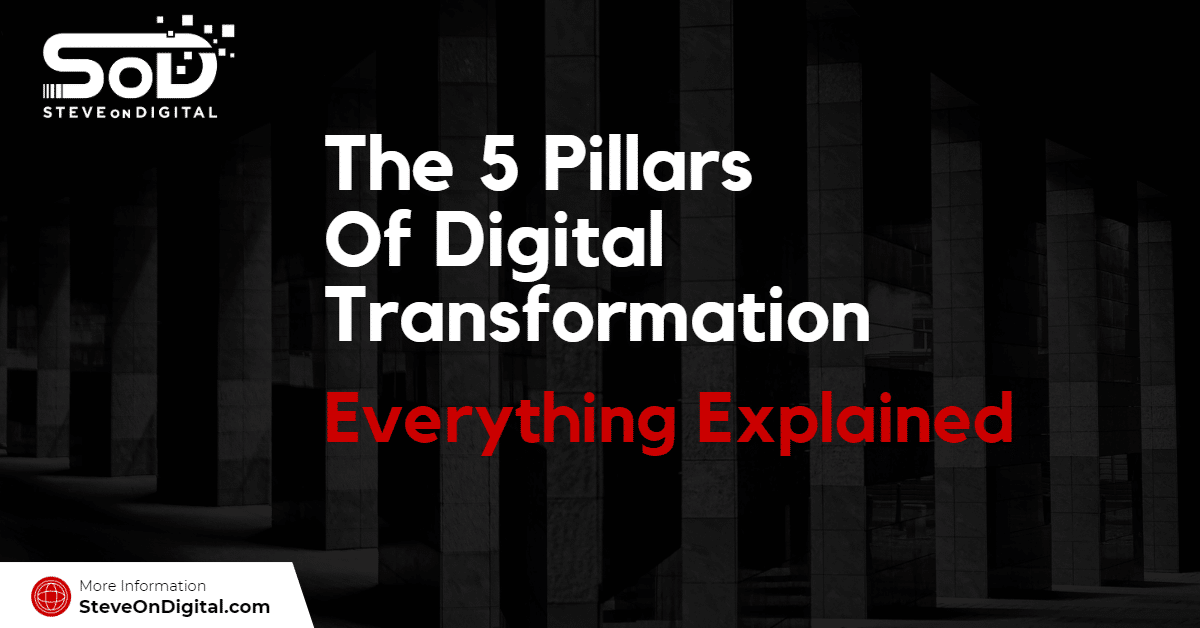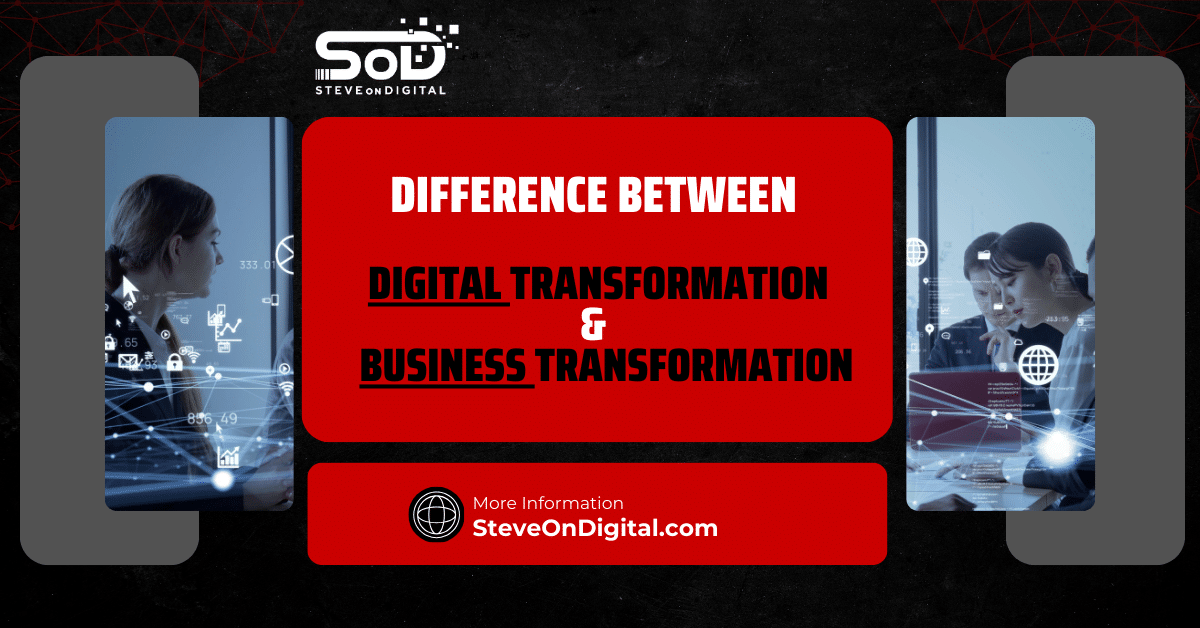The 5 pillars of digital transformation are digital mindset, digital strategy, customer experience, data-driven decision-making, and digital technologies. These core, five key elements will guide businesses through the process of integrating digital technologies into their operations, driving significant improvements and long-term success.
Digital transformation involves more than just updating technology; it requires a shift in mindset and strategy. By focusing on these five pillars, businesses can navigate their digital transformation journey effectively, enhancing their organization’s ability to innovate, improve customer satisfaction, and stay competitive in an increasingly digital world.
I’m Steve, a digital transformation expert with a strong background in electrical engineering, an MBA, and a master’s in Project Management. I excel at helping SMEs navigate the digital landscape with practical insights. Let’s begin!
Understanding the 5 Pillars of Digital Transformation
The journey to a successful digital transformation rests on five key pillars: digital mindset, digital strategy new business models, customer experience, data-driven decision making, and digital technologies. These pillars provide a comprehensive framework to guide businesses through their digital transformation efforts.
| Pillar | Description |
|---|---|
| Digital Mindset | Adopting a forward-thinking approach and being open to change. |
| Digital Strategy | Aligning digital initiatives with overall business goals. |
| Customer Experience | Enhancing interactions through personalized, seamless experiences. |
| Data-Driven Decision Making | Leveraging data to inform strategic business decisions. |
| Digital Technologies | Utilizing emerging technologies to transform business processes. |
Digital Mindset
Cultivating and creating a digital mindset is essential for any organization looking to thrive in today’s digital age. It involves adopting a forward-thinking approach and being open to change.
Embracing Change
To foster a culture open to technological advancements and innovation, businesses must encourage flexibility and adaptability. This can be achieved by promoting a growth mindset among employees and celebrating innovation. For example, when I implemented a new project management tool in my company, it streamlined our processes and improved efficiency. The key was to involve everyone in the transition and highlight the benefits of the new technology.
Continuous Learning
Staying updated with new technologies requires continuous learning. Encouraging ongoing education and skill development helps keep pace with technological advancements. I often attend workshops and online courses to stay ahead and bring fresh insights to my business. Providing employees with access to training resources ensures that everyone is equipped to handle new digital tools and processes.
| Benefit | Impact |
|---|---|
| Increased Innovation | Fosters a culture of creativity and problem-solving. |
| Improved Efficiency | Streamlines processes and reduces operational costs. |
| Enhanced Employee Morale | Encourages continuous learning and professional development. |
Digital Strategy
A well-crafted digital strategy aligns digital products with your overall business goals, ensuring that digital transformation efforts are targeted and effective.
Aligning with Business Objectives
Your digital strategy should support and enhance your business strategy. This involves identifying how digital tools can help achieve your business goals. For instance, when I aligned my digital marketing efforts with my business objectives, I saw a significant increase in customer engagement and sales.
Defining Clear Goals and Metrics
Setting measurable objectives is crucial for tracking progress and success. Establish key performance indicators (KPIs) that align with your digital strategy. Regularly review these metrics to ensure your digital initiatives are on track. When I set clear goals for my website traffic and conversion rates, it became easier to measure the effectiveness of my digital marketing campaigns.
| Metric | Description | Example |
|---|---|---|
| Customer Engagement | Measures interaction with digital channels. | Social media likes, shares, and comments. |
| Conversion Rate | Percentage of visitors who complete a desired action. | Purchases, sign-ups, or downloads on the website. |
| Return on Investment (ROI) | Financial gain compared to the investment cost. | Revenue generated from a marketing campaign. |
Customer Experience
Enhancing customer interactions through digital means is a cornerstone of digital transformation. A seamless, personalized experience can significantly improve customer satisfaction and loyalty.
Personalized Services
Using data to create tailored customer experiences is a powerful way to enhance engagement. For example, analyzing customer behavior on my website allowed me to offer personalized product recommendations, which increased sales and customer satisfaction.
Omni-Channel Engagement
Providing seamless interactions across various digital platforms ensures that customers have a consistent experience regardless of how they interact with your business. Implementing an omni-channel strategy helped me connect with customers on social media, email, and my website, providing a unified and satisfying experience.
Data-Driven Decision Making
Leveraging data assets to inform strategic decisions is critical for modern businesses. Data-driven decision-making involves collecting and analyzing data to guide business strategies and improvements.
Data Collection and Analysis
Gathering and analyzing data effectively can reveal valuable insights about your business and customers. Utilizing tools like Google Analytics and CRM systems can help you collect and interpret data to make informed decisions. By regularly analyzing website traffic and customer feedback, I identified key areas for improvement in my business operations.
| Tool | Purpose | Features |
|---|---|---|
| Google Analytics | Website data analysis | Tracks website traffic, user behavior, and conversions. |
| Tableau | Data visualization and business intelligence | Creates interactive and shareable dashboards. |
| CRM Systems (e.g., Salesforce) | Customer data management | Manages customer interactions and automates sales processes. |
Implementing Insights
Using data insights to drive business improvements ensures that your strategies are based on solid evidence. For example, data analysis showed that my customers preferred mobile browsing, leading me to optimize my website for mobile devices, resulting in increased user engagement and sales.
Digital Technologies
Utilizing new technology to transform business processes is a fundamental aspect of digital transformation. Staying abreast of technological advancements and integrating them into your own business model can provide a competitive edge.
Emerging Technologies
Keeping an eye on cutting-edge technologies can help you identify new opportunities for innovation and new ideas. Technologies like artificial intelligence, machine learning, and blockchain are reshaping industries and offering new possibilities for business growth. When I incorporated AI-driven tools into my marketing strategy, it enhanced my ability to target and engage customers more effectively.
| Technology | Description | Business Application |
|---|---|---|
| Artificial Intelligence (AI) | Machines simulating human intelligence. | Chatbots, predictive analytics, personalized marketing. |
| Machine Learning (ML) | Algorithms improving through experience. | Fraud detection, customer segmentation, demand forecasting. |
| Blockchain | Decentralized digital ledger technology. | Secure transactions, smart contracts, supply chain transparency. |
Integration and Implementation
Successfully integrating new technologies into existing systems requires careful planning and execution. Developing a clear implementation strategy ensures a smooth transition and maximizes the benefits of new technologies. When I introduced a new CRM system, a step-by-step integration plan helped minimize disruptions and quickly reap the rewards of improved customer relationship management.
The Role of Leadership in Digital Transformation
Leadership plays a pivotal role in driving and sustaining digital transformation. A clear vision and effective strategies from leadership can make all the difference in a successful transformation. In my experience, a strong leader can inspire change and navigate the complex landscape of digital transformation.
Vision and Strategy
Having a clear vision and strategy is crucial for leadership in digital transformation. It sets the direction and tone for the entire process.
Communicating the Vision
Ensuring all employees understand and support the digital transformation vision is essential. This involves clear and consistent communication. When I rolled out a new digital initiative in my company, I held several town hall meetings to explain the vision and answer questions. This transparency helped gain buy-in from the team.
Leading by Example
Leaders must demonstrate their commitment to digital initiatives. By embracing digital tools and technologies themselves, leaders can set a positive example for their teams. I make it a point to use the latest project management tools and participate in digital training programs alongside my employees. This shows my commitment and encourages others to follow suit.
Change Management
Managing the human aspects of digital transformation is often the most challenging part. Effective change management involves engaging employees and providing the necessary support.
Employee Engagement
Involving employees in the transformation process is key to success. This can be done by seeking their input and involving them in decision-making. For instance, I created a cross-functional team to provide feedback on our digital strategy. This inclusion made employees feel valued and more invested in the transformation.
Training and Support
Providing the necessary resources and training is crucial to support employees through the transformation. I implemented regular training sessions and created a resource hub with tutorials and FAQs. This ensured that everyone had access to the information they needed to adapt to new processes and tools.
Implementing Digital Transformation
Effective implementation of a digital transformation strategy requires thorough planning and continuous monitoring.
Planning and Preparation
Thorough planning and preparation set the foundation for the successful execution of digital transformation efforts.
Conducting a Digital Audit
Assessing current digital capabilities and identifying gaps is the first step. A digital audit helps understand where your organization stands and what needs improvement. When I conducted a digital audit for my company, it revealed several areas that needed upgrading, such as outdated software and inefficient processes.
Setting Realistic Timelines
Establishing achievable timelines for digital initiatives is crucial to avoid burnout and ensure steady progress. I found that breaking down key elements of the transformation into smaller, manageable phases with clear deadlines helped maintain momentum and track progress effectively.
Execution and Monitoring
Executing and monitoring digital transformation efforts require flexibility and a willingness to evolve and adapt.
Agile Methodologies
Utilizing agile approaches allows organizations to adapt and iterate quickly. This involves implementing changes in small increments, testing, and refining them based on feedback. Adopting agile methodologies in my projects enabled faster turnaround times and improved outcomes.
Regular Reviews and Adjustments
Continuously reviewing and refining the transformation process ensures it stays on track. Regular check-ins and performance reviews help identify areas that need adjustment. I schedule monthly reviews with my team to discuss progress, challenges, and potential improvements.
Overcoming Challenges in Digital Transformation
Digital transformation comes with its fair share of challenges. Addressing these obstacles effectively is critical to achieving success.
Resistance to Change
Resistance from employees is a common challenge in digital transformation. Addressing this resistance requires effective communication and trust-building.
Effective Communication
Keeping lines of communication open and transparent helps address concerns and mitigate resistance. I hold regular meetings and encourage open dialogue to discuss any apprehensions related to the transformation.
Building Trust
Establishing trust through consistent and honest communication is vital. Demonstrating the benefits of digital transformation and showing empathy towards employees’ concerns can build trust. When I shared success stories from other teams and departments, it helped alleviate fears and build confidence in the transformation process.
Technical Challenges
Dealing with technical issues and integration challenges is another significant hurdle in digital transformation.
Robust IT Infrastructure
Ensuring the IT infrastructure can support digital initiatives is crucial. This involves upgrading hardware, software, and network capabilities. I invested in a robust IT infrastructure to support our digital tools and processes, which significantly improved our operational efficiency.
Cybersecurity
Implementing strong cybersecurity measures to protect digital assets is essential. With increasing cyber threats, safeguarding data and systems is a top priority. I worked closely with our IT team to implement comprehensive cybersecurity protocols, ensuring our digital transformation journey was secure.
Measuring the Success of Digital Transformation
Evaluating the success of digital transformation efforts involves tracking key metrics and key performance indicators (KPIs). By measuring financial and operational impacts, businesses can determine if their digital transformation journey is on the right track.
Financial Metrics
Understanding the financial impact and value of digital transformation is crucial. This includes measuring return on investment (ROI) and conducting cost-benefit analyses.
ROI Calculation
Calculating the return on investment for digital initiatives helps gauge their financial performance. To do this, compare the gains from digital investments against their costs. For example, when I invested in a new customer relationship management (CRM) system, I tracked the increase in sales and customer retention, comparing it to the system’s cost. This provided a clear picture of the ROI.
Cost-Benefit Analysis
Conducting a cost-benefit analysis helps businesses weigh the expenses against the anticipated benefits of digital projects. I often use this method to decide on new technology investments, ensuring that the long-term benefits outweigh the initial costs.
Operational Metrics
Assessing improvements in operational efficiency and productivity is another vital aspect of measuring digital transformation success.
Efficiency Metrics
Key indicators of operational efficiency include reduced process time and increased throughput. For instance, implementing an automated workflow system in my company cut down processing times by 30%, significantly boosting efficiency.
Productivity Metrics
Measuring productivity gains from digital transformation involves tracking metrics like output per employee and project completion rates. After introducing digital tools for project management, I noticed a 20% increase in team productivity, reflecting the positive impact of these tools.
Case Studies of Successful Digital Transformation
Real-life examples of companies that have successfully implemented digital transformation can provide valuable insights and inspiration.
Large Companies
Large organizations often lead the way in digital transformation, setting benchmarks for others.
Company A Case Study
Company A’s digital transformation journey involved integrating artificial intelligence (AI) into their customer service operations. By deploying AI chatbots, they improved customer response times and satisfaction rates, resulting in a 25% increase in customer retention.
Company B Case Study
Company B successfully adopted a data-driven approach to decision-making. By implementing advanced data analytics tools, they gained deeper insights into market trends and customer behavior, leading to a 15% increase in sales within a year.
SMEs
Small and medium-sized enterprises (SMEs) can also achieve remarkable digital success with the right strategies.
SME A Case Study
SME A leveraged digital marketing strategies to enhance its online presence. By focusing on search engine optimization (SEO) and social media marketing, they saw a 40% increase in website traffic and a significant boost in sales.
SME B Case Study
SME B focused on improving internal processes through digital tools. Implementing a cloud-based project management system helped them streamline operations, leading to a 30% reduction in project delivery times.
Tools and Resources for Digital Transformation
A wide range of tools and resources can aid in the digital transformation journey for most businesses, from software and platforms to educational materials.
Software and Platforms
Selecting the right software and platforms is crucial for successful digital initiatives.
CRM Systems
Customer Relationship Management (CRM) systems are invaluable for managing customer interactions and data. They help businesses build stronger relationships with customers and improve sales processes. I use a CRM system to track customer interactions and manage sales pipelines efficiently.
Data Analytics Tools
Data analytics tools enable businesses to analyze and leverage data for informed decision-making. Tools like Google Analytics and Tableau provide insights into customer behavior and operational performance, driving better business decisions.
Educational Resources
Continuous learning is essential for keeping up with digital transformation trends, skills, and technologies.
Online Courses
Several online courses offer in-depth knowledge on digital transformation. Platforms like Coursera and Udacity provide courses on digital strategy, data analytics, and emerging technologies, which I have found incredibly beneficial for staying updated.
Books and Publications
Key books and publications on digital transformation can offer valuable insights and strategies. Books like “Digital Transformation: Survive and Thrive in an Era of Mass Extinction” by Thomas M. Siebel provide comprehensive guides on navigating the digital landscape.
Final Thoughts
Digital transformation is a complex but rewarding journey. By focusing on the five pillars—digital mindset, digital strategy, customer experience, data-driven decision-making, and digital technologies—businesses can achieve long-term success. It’s essential to measure progress, learn from successful case studies, and utilize the right tools and resources. With commitment and the right approach, digital transformation can lead to significant improvements in efficiency, productivity, and customer satisfaction.





